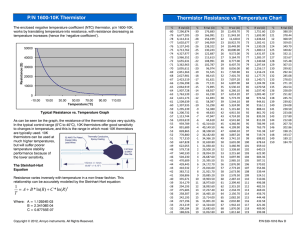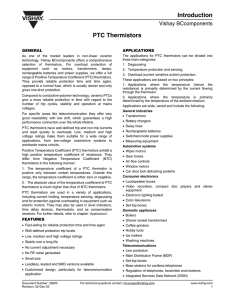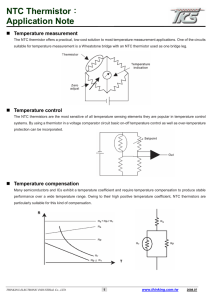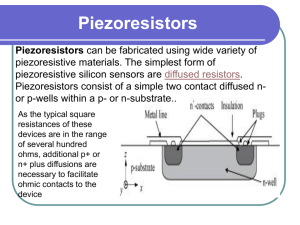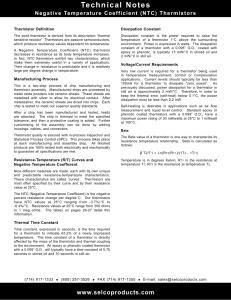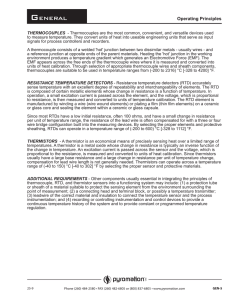Thick Film Thermistors Printed on Low Temperature Co
advertisement
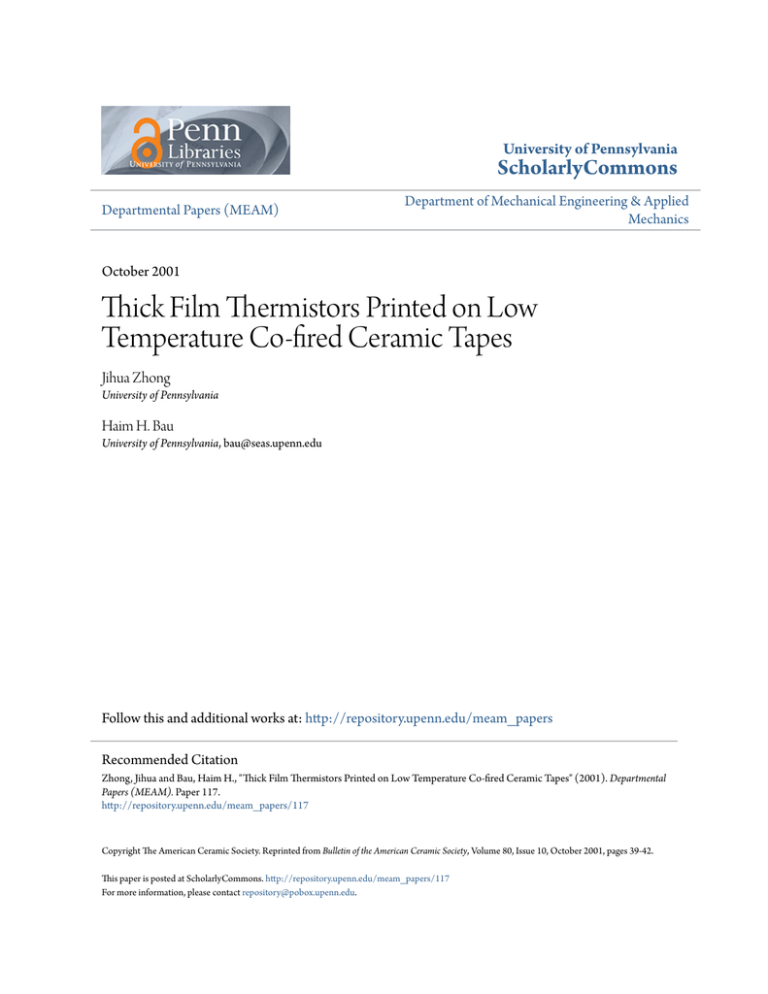
University of Pennsylvania ScholarlyCommons Departmental Papers (MEAM) Department of Mechanical Engineering & Applied Mechanics October 2001 Thick Film Thermistors Printed on Low Temperature Co-fired Ceramic Tapes Jihua Zhong University of Pennsylvania Haim H. Bau University of Pennsylvania, bau@seas.upenn.edu Follow this and additional works at: http://repository.upenn.edu/meam_papers Recommended Citation Zhong, Jihua and Bau, Haim H., "Thick Film Thermistors Printed on Low Temperature Co-fired Ceramic Tapes" (2001). Departmental Papers (MEAM). Paper 117. http://repository.upenn.edu/meam_papers/117 Copyright The American Ceramic Society. Reprinted from Bulletin of the American Ceramic Society, Volume 80, Issue 10, October 2001, pages 39-42. This paper is posted at ScholarlyCommons. http://repository.upenn.edu/meam_papers/117 For more information, please contact repository@pobox.upenn.edu. Thick Film Thermistors Printed on Low Temperature Co-fired Ceramic Tapes Abstract Focuses on the importance of ceramic tapes as a substrate material for hybrid microelectronic circuits. Fabrication of thermal reactor; Importance in monitoring temperature; Utilization of layered manufacturing and rapid prototyping processes. Keywords Ceramaic Materials, Industrial Applications, Microelectronics Comments Copyright The American Ceramic Society. Reprinted from Bulletin of the American Ceramic Society, Volume 80, Issue 10, October 2001, pages 39-42. This journal article is available at ScholarlyCommons: http://repository.upenn.edu/meam_papers/117 Thick Film Thermistors Printed on Low Temperature Co-fired Ceramic Tapes Bulletin of the American Ceramic Society, Volume 80, Issue 10, pages 39-42. Pastes can be used with low-temperature cofired ceramic tapes to form PTC and NTC thermistors. Low-temperature, cofired ceramic (LTCC) tapes are commonly used as a substrate material for hybrid microelectronic circuits.[1,2] Recently, it has been recognized that ceramic tapes also can be used as an efficient and convenient medium for the manufacturing of mesoscale electromechanical components and systems, in particular mesoscale fluidic systems for laboratories on a chip[3,4] and microchemical reactors. Ceramic tapes are attractive, because they are easy to machine in the green state, and they facilitate easy integration of microfluidic components, electronic conductors, resistors and electrodes using layered manufacturing and rapid prototyping processes. In many of the systems fabricated using ceramic tapes, temperature needs to be monitored. For example, in electronic packaging, in-situ temperature monitoring can be used to control cooling systems and provide a safe shutdown in the event of overheating. When ceramic tapes are used as substrate materials for sensors, temperature measurement is required for thermal compensation. Moreover, in microfluidic devices, temperature measurement is needed for flow-rate monitoring[5] and for controlling temperature in minute chemical and biological reactors. For example, thermal reactors that allow very rapid cycling of the temperature in a preprogrammed manner have been recently developed using LTCC tapes. One application of these reactors is to facilitate polymerase chain reaction (PCR).[6] A convenient temperature sensor for integration within the ceramic tapes system is the thermistor. By monitoring thermistor resistance, its temperature can be determined. There are two types of thermistors: positive temperature coefficient (PTC) and negative (NTC) temperature coefficient. Thermistors are widely used, and they are available as pastes that can be printed and fired on substrate materials, such as alumina. Unfortunately, the application of existing pastes to LTCC systems is not straightforward. Because of shrinkage mismatch and differences in thermal expansion coefficients, the thermistors may cause the tapes to deform during the firing process. Moreover, physicochemical interactions between the paste and the tape materials may affect thermistor characteristics. We printed and tested DuPont PTC 5092D, NTC40 and NTC50 pastes on DuPont 951 LTCC tapes to form thermistors. These thermistor pastes were designed for use on fired alumina substrates. Here, we report on the characteristics of these pastes when printed on LTCC tapes. Some of the thermistors were embedded between layers of tapes. Others were mounted on the surface of the tapes. In both cases, the thermistors were cofired with the tapes. Other thermistors were mounted on previously fired tapes. Subsequent to the fabrication process, thermistor resistances were measured as functions of temperature. The Experiment DuPont PTC5092, NTC40 and NTC 50 pastes of various sizes were printed on DuPont 951 LTCC tapes having a 250 mm nominal thickness. Conductor paths were formed using DuPont silver paste 6142D, and vias were filled with DuPont silver paste 6141. Soldering pads made of DuPont silver paste 6146 were used to connect leads to the thermistors. Typically, the order of the printing was 6141, 6142D, 6146 and NTC or PTC. After each printing step, the paste was allowed to dry for is similar to 3 min at 120 degrees C. Next, the various layers were aligned and laminated at 70 degrees C and 3000 psi (21 MPa) for 5 min; the sample was then turned 180 degrees and subjected again to 70 degrees C and 3000 psi for another 5 min. Finally, the samples were fired in air. In the cases of postfired thermistors, the paste was applied after the firing process. All the thermistors were is similar to 30 mu m thick prior to firing. Embedded thermistors were 10 mm long and 1 mm wide. Postfired thermistors were 13 mm long and 1 mm wide. The surface-mounted, cofired PTC thermistors were printed in five different sizes, and their fired dimensions ranged from 16 to 42 mm in length and from 0.8 to 3.6 mm in width. In all cases, postfired thermistors included a standard firing process. The oven temperature was ramped at 10 degrees C/min to 350 degrees C, and it was maintained at this temperature for is similar to 45 min to burn out the organic binder. The temperature then was ramped at 10 degrees C/min to 875 degrees C and maintained at this temperature for is similar to 30 min. The oven then was allowed to cool to room temperature. Neither the cofired, surface-mounted and embedded PTC thermistors nor the postfired PTC and NTC thermistors exhibited significant deformations. In contrast, when mounted on prefired surfaces, the cofired NTC thermistors exhibited serious deformations. The problem was much reduced, but not completely eliminated, when the NTC thermistors were sandwiched between layers of green tapes. These deformations were apparently caused by shrinkage mismatch between the NTC paste and the ceramic tape. These deformations could be reduced by decreasing thermistor dimensions, increasing the number of tape layers and/or printing symmetrically paste formulations on both sides of the tape. Subsequent to the fabrication process, lead wires were soldered to the soldering pads to facilitate the measurement of thermistor resistance. The resistance measurements were conducted using a multimeter (Model HP 3458A, Hewlett-Packard, Palo Alto, Calif.). In all cases, the electrical resistance of the lead wires and printed conductors was <0.02% of the thermistor resistance, and it was neglected. The calibration experiments were conducted in a constant-temperature bath (Model RTE110, NESLAB Instruments Inc., Portsmouth, N.H.) whose temperature was monitored using a digital readout and a mercury thermometer. To avoid contact between the various conductors and the bath water, the test sample was sealed in a plastic pouch with a mercury thermometer having 0.1 degrees C divisions. Ample time was allowed for the sample temperature to equilibrate with the bath temperature. The bath temperature was varied from 5 to 95 degrees C in increments of 5 degrees C. This temperature range was consistent with the intended application of monitoring the temperature of biological reactors fabricated in ceramic tapes. It was anticipated, however, that the thermistors could successfully be used over a much wider temperature range. Demonstrating high-temperature measurements was precluded, because lowtemperature solder was used to connect the leads to the soldering pads. PTC Thermistors The PTC resistance, R(T), was correlated as a function of the temperature, T (in kelvin), using the linear expression, R(T)/R(298) = 1 + alphaPTC(T - 298) (1) where alpha (in K-1) is the temperature coefficient of resistance (TCR). Regression analysis suggested, with a high level of confidence, a linear relationship between thermistor resistance and temperature. The average alpha values for embedded and cofired, surface-mounted and cofired, and surface-mounted and postfired thermistors were, respectively, 0.0032 (3.7%) K-1, 0.00376 (2%) K-1 and 0.00367 (0.2%) K-1. The reported value of a for a similar thermistor fired on alumina is is similar to 0.00300 +/- 0.0020 K-1. In the above, the numbers in the parentheses indicate standard deviations. The least scatter in the alpha values was observed for the surface-mounted, postfired thermistors. The largest scatter for the alpha values of the embedded and cofired thermistors may indicate diffusion interactions between the ceramic tapes and the thermistor material. NTC Thermistors The dependence of the NTC resistance on temperature is described approximately by R(T)/R(298) = 1 + c(T - 298) x exp[beta(1/T - 1/298)] (2) We correlated the normalized resistance, ln(R(298)/R(T)), with (1/298) - (1/T) and found almost linear dependence. When c = 0, we found, respectively, beta values of 1731 K (4.9%), 2139 K (5.9%), 2452 K (2.2%) and 2856 K (3.5%) for postfired and surface- mounted NTC40, postfired and surface-mounted NTC50, cofired and embedded NTC40 and cofired and embedded NTC50. When mounted on alumina, betaNTC40 is greater than or equal to 1500 K and beta NTC50 is greater than or equal to 2500 K. We demonstrated that the PTC and NTC thermistor pastes could be used in conjunction with LTCC tapes. Calibration curves were obtained for cofired and postfired thermistors. Relatively high scatter was observed in thermistor coefficients. Additional work is needed to achieve a better process uniformity. Currently, to achieve sufficiently precise temperature measurements, it is necessary to obtain an individual calibration curve for each thermistor. Acknowledgment Supported in part by DARPA under Grant No. N66001-97-1-8911. DuPont provided us freely with advice and materials. GRAPH: Normalized resistance, R(T)/R(298), as a function of the temperature, T, for (*[This character cannot be converted to ASCII text]) embedded and cofired, (*[This character cannot be converted to ASCII text]) surface-mounted and cofired, and (*[This character cannot be converted to ASCII text]) surface-mounted and postfired PTC thermistors. Solid lines represent best-fit straight lines, and the symbols correspond to the experimental data. GRAPH: Natural logtithm of the normalized resistance, ln R(T)/R(298) as a function of (1/298) - (1/T) ((*[This character cannot be converted to ASCII text]) postfired and surface-mounted NTC40, (*[This character cannot be converted to ASCII text]) postfired and surface-mounted NTC50, (*[This character cannot be converted to ASCII text]) cofired and embedded NTC40 and (*[This character cannot be converted to ASCII text]) cofired and embedded NTC50). DIAGRAM: Thermal reactor fabricated with LTCC tapes. Schematic description of the various layers and a cross section of the device are depicted, and an actual component is shown. Various layers were machined individually. Resistance heater and lead conductors were printed on layer (1). Layer (2) contains vias for the conductors. Fluid conduit was fabricated in layer (3), and the thermistor was printed on layer (4). Various layers were stacked, aligned, laminated and cofired to form the monolithic component shown. Deformations caused by the presence of the buried resistors and conduits are insignificant. Heater and thermistor were connected through an external feedback loop, and the temperature was varied as a function of time in a prescribed way. Many such components were accommodated on a single substrate. 1. W. Borland, "Thick-Film Hybrids"; pp. 332-53 in Electronic Materials Handbook, Vol. 1, Packaging. ASM International, Materials Park, Ohio, 1989. 2. R. D. Jones, Hybrid Circuit Design and Manufacture, Ch. 4; p. 40. Marcel Dekker, New York, 1982. 3. H. H. Bau, G. K. Ananthasuresh, J. J. Santiago-Aviles, J. Zhong, M. Kim, M. Yi and P. Espinoza-Vallejos, "Ceramic-Tape-Based Systems Technology"; pp. 49198 in Micro-Electro-Mechanical Systems (MEMS), DSC, Vol. 66. 1998. 4. M. Kim, M. Yi, J. Zhong, H. H. Bau, H. Hu and G. K. Ananthasuresh, "The Fabrication of Flow Conduits in Ceramic Tapes and the Measurement of Fluid Flow through These Conduits"; see Ref. 3, pp. 171-77. 5. M. Gongora-Rubio, L. M., Sola-Laguna, P. J. Moffett and J. J. Santiago-Aviles, "The Utilization of Low-Temperature Cofired Ceramics (LTCC-ML) Technology for Meso Scale EMS, A Simple Thermistor-Based Flow Sensor," Sens. Actuators, 73, 215 (1999). 6. J. Zhong, M. Yi and H. H. Bau, "A Thermal Cycler Fabricated with LowTemperature Cofired Ceramic Tapes"; pp. 123-28 in IMECE 1999, MEMS 1999 Symposium Proceedings, MEMS, Vol. 1 (Nashville, Tenn., Nov. 14-19, 1999). 7. L. M. Sola-Laguna, P. J. Moffett, J. R. Larry and J. Hormadaly, "Thick-Film NTC Thermistor Series for Sensor and Temperature Compensation Application," IMAPS, 1998. ~~~~~~~~ By Jihua Zhong, Dept. Mechanical Engineering and Applied Mechanics, University of Pennsylvania, Philadelphia, Pa. and Haim H. Bau, Dept. Mechanical Engineering and Applied Mechanics, University of Pennsylvania, Philadelphia, Pa.
